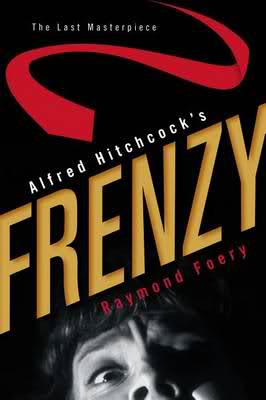| Raymond Foery, Alfred Hitchcock’s Frenzy: The Last Masterpiece. Maryland and Plymouth: Scarecrow Press, Inc. ISBN 9780810877559 US $40.00 (hb) 187pp (Review copy supplied by Scarecrow Press) |
 |
Alfred Hitchcock returned to his native England to make Frenzy (1972), which turned out to be the director’s penultimate film. In the text under discussion, Raymond Foery explores this movie’s production and critical reception.
At the book’s beginning, Foery explains that Hitchock “had something to prove by 1971” (1). His most recent films, Torn Curtain (1966) and Topaz (1969), had been critical and commercial disasters. Fortunately, Universal Studios “were eager to give the master one more project, certainly if it could be a relatively low-budget one” (1). After reviewing numerous film ideas, Hitchcock stumbled upon Arthur La Bern’s 1966 novel Goodbye Piccadilly, Farewell Leicester Square. Universal had recently acquired the rights to La Bern’s text, which would form the basis for Frenzy.
Foery goes on to describe Frenzy’s production. He pays close attention to the filming of “signature sequences” such as the one in which the camera tracks slowly away from an apartment that will soon become a crime scene. Foery describes the mixed responses that this film has received from scholars, particularly feminist scholars. This emphasis on Frenzy’s feminist reception is significant given its plot (a man is wrongly accused of committing various rape-murders) and its depictions of sexual violence. Foery concludes by assessing the film’s legacy forty years after its initial cinematic release.
A highlight of The Last Masterpiece is Foery’s broad-ranging research. Foery has consulted production notes, scholarly articles, Hitchcock biographies and media reviews of Frenzy. I was particularly enthralled by the descriptions of how Hitchcock tried to recreate “the London of his memories” (32). Though set in the 1970s, the film (mostly) eschews modish trappings. Much of Frenzy was shot at Covent Garden’s open air market, which was scheduled for demolition in 1974 (33). Hitchcock also scouted around for a pub with “dark wood” to shoot a number of pivotal scenes (34). Such a pub would have to be far removed from the “psychedelic nature” of the “modern” pubs that the director allegedly came across (34).
Throughout the book, Foery provides a corrective to various myths surrounding Hitchcock. The first myth is encapsulated in the following statement, which has often been attributed to the director: “All actors are cattle” (36). Hitchcock clarified that his actual line was: “(A)ctors should be treated like cattle” (36). This kind of line is not particularly humane. That said, Foery convincingly argues that “Hitchcock managed to elicit some quite profound performances from his actors” (36). The nuanced performances delivered by Frenzy’s cast members support this argument.
Also, Foery investigates Hitchcock’s rumoured “fear and loathing of women” (139). This fear and loathing has most recently been alleged by the actress Tippi Hedren, who is best known for her appearances in the director’s The Birds (1963) and Marnie (1964).[1] Foery acknowledges Hitchcock’s close personal and professional relationships with a number of women. These include his wife, the screenwriter Alma Reville. Foery concedes that Frenzy has received a mixed response amongst feminists. Some have charged the film with misogyny (136-137). This charge has stemmed largely from the excruciatingly protracted rape-murder of the character Brenda (Barbara Leigh-Hunt) by the film’s villain, Rusk (Barry Foster). Conversely, some feminists have regarded the film’s gender politics to be more ambivalent.[2]
Foery refuses to prioritise one feminist response to Frenzy over another, which is a wise move. I would, in fact, suggest the film can be read as being both misogynist and anti-misogynist. I have long been disturbed by the way in which the director attempts to evoke black humour in scenes of sexual violence. At the same time, Hitchcock portrays this violence as being indescribably ugly and inhumane. It would be difficult to argue that the film glamorises female subjugation.
My one criticism with The Last Masterpiece concerns Foery’s failure to justify his choice of cinematic text. Why write an entire monograph about Frenzy, as opposed to any other Hitchcock movie? Such a justification of film choice would be particularly useful to those viewers who either have not seen Frenzy or who do not necessarily agree that the film constitutes a “masterpiece”. On this last point: I find the term “masterpiece” jarring in its triteness. I can only assume that this term was added to the title of Foery’s text in order to enhance the book’s commercial appeal.
As a whole, The Last Masterpiece provides an engaging snapshot of Hitchcock’s creative brilliance. The film also offers an absorbing insight into an intriguing – not to mention highly disturbing – film.
[1] See Sarah Malm, ‘Hitchcock star says director was ‘evil’ and she’d be rich if sexual harassment laws applied in the 1960s’, Mail Online, (2 August 2012), http://www.dailymail.co.uk/news/article-2182804/Hitchcock-star-Tippi-Hedren-says-director-evil-shed-rich-sexual-harassment-laws-applied-1960s.html (accessed 9 September 2012).
[2] For example, Foery cites Tania Modleski’s suggestion that Frenzy does not necessarily endorse “all the violence (against women) it portrays” (cited on p.139). Modleski argues that the “fear and loathing” of women in some Hitchcock films “is accompanied by a lucid understanding of – and even sympathy for – women’s problems in patriarchy” (cited on p.139).
